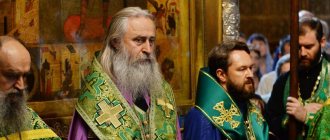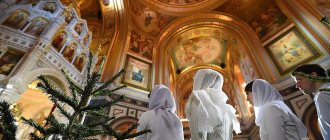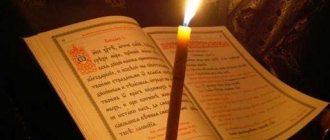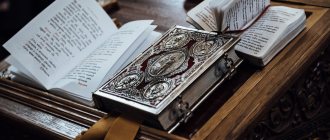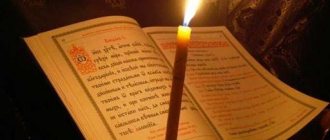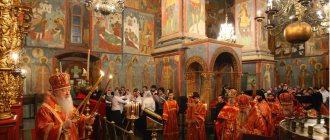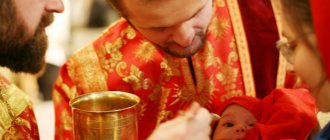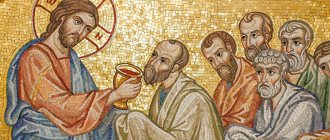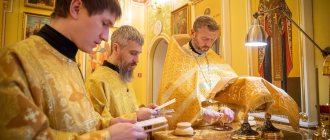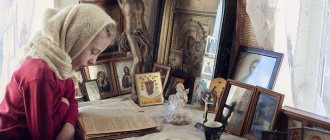The concept of Liturgy and its origin
The first place among church services is occupied by the Liturgy. During the Liturgy, the Most Holy Sacrament of Communion is celebrated, established by our Lord Jesus Christ on Thursday evening, on the eve of the Passion of the Cross.
Having washed the feet of His Disciples to set an example of humility, the Lord took bread, blessed it, broke it and gave it to the Disciples, saying: “Take, eat, this is My Body,” then He took a cup of grape wine and, praising God, gave it to the Disciples, saying: “Drink of it, all of you, for this is My Blood of the New Testament, which was shed for many for the remission of sins.” (Matt. XXVI, 26–28).
Having given communion to the Apostles, the Lord gave them the commandment to always perform this Sacrament: “Do this in remembrance of Me.” (Luke XXII, 19; 1 Cor. XI, 24).
The apostles actually performed Holy Communion according to the commandment and example of Jesus Christ and commanded to perform the Sacrament of Holy Communion in every newly emerging Christian community.
At first, the ritual and order of performing the Liturgy were transmitted orally, then a written presentation of the Liturgy began to appear. The liturgy little by little began to be enriched with new prayers, chants and sacred actions.
The Liturgy has always been celebrated and will be celebrated until the end of time in the Church of Christ, for through Holy Communion we enter into unity with Jesus Christ and are cleansed of our sins. The very word Communion or Communion, that is, communication and participation, means that thanks to this Sacrament we enter into communion, firstly, with Jesus Christ and, secondly, with each other.
The first communion is spoken of in the words of Jesus Christ: “He who eats My Flesh and drinks My Blood abides in Me, and I in him” (John VI, 54–56); about the second - in the words of the Apostle Paul: “There is one bread, one body we are many; for of one body we partake” (1 Cor. X, 16, 17).
Divine Liturgy with explanations - download, listen online
There is also a wonderful lecture by Protodeacon Andrei Kuraev on the Divine Liturgy, in which a detailed explanation of the Orthodox rite is given in clear language and easy style (understandable even for dummies in this matter).
Lectures by Protodeacon Andrei Kuraev, replete with explanations, can be found in video and audio format, watch and listen online, and also download. Such materials are recommended for familiarization both to people beginning their Orthodox path and to churchgoers.
The Divine Liturgy should not be confused with the funeral service, which is called a memorial service. This service is distinguished by the fact that it commemorates the deceased; it is served on the day of death of the deceased, also on the 3rd, 9th, 40th day, and on every anniversary after death, on birthdays, name days.
The memorial service can be served either in church by a priest or at home by a layman. During this service, trusting in God’s mercy, the Lord asks for forgiveness of sins for the deceased and eternal life.
Perhaps it is useful for everyone to know what not to do on church holidays.
Rules of conduct during service
How to behave at a worship service:
- know in advance the exact start and duration of the service and arrive 15 minutes earlier;
- conversation is prohibited;
- remain calm without moving from foot to foot;
- do not consider those around you and the decoration of the temple, do not look around;
- turn off your mobile phone;
- if the wake is held for the whole night, that is, more than 2–3 hours, you can sit on a bench;
- greet the opening of the Royal Gates standing;
- During the service, do not turn your back to the altar;
- If you need to leave before the end of the service, you should check in and leave without attracting attention;
- light candles, take notes before the start of the service so as not to disturb those praying;
- Women are forbidden to kiss the cross with painted lips.
If you know in advance that you won’t be able to fully protect your serve, it’s better to sit closer to the exit.
What is liturgy in church
This is the main Christian service, it is also called mass - the basis and center of the entire church world.
The purpose of this sacred tradition is preparation for the sacrament of the Eucharist or Communion, which occurs at the end of the service.
The first Eucharist was celebrated by Jesus Christ on Maundy Thursday.
This is interesting: Maundy Thursday (otherwise Maundy Thursday, Holy Thursday) is the fourth day of Great Week. On this day, followers of the Christian faith remember the Last Supper. It was then that Jesus Christ washed the feet of the apostles and established the sacrament of Communion. Surrounded by His disciples, Christ blessed the bread, which is His Body, and the wine, which is His Blood, and said: “Take, eat: this is My Body” (Matthew 26:26; Mark 14:22; Luke 22:19 ).
It is during this main church service that the remembrance of the deceased takes place according to notes “For the Repose” and for health according to the notes “For Health” submitted by Christians. It is recommended to submit notes before the start of the service, and preferably in the evening - during the evening service.
Origin of the Orthodox Liturgy
As stated earlier, the Eucharist forms the basis of liturgical worship. In Ancient Greece there was such a thing as the “Eucharist”.
Translated from Greek into Russian, this word means “common cause.” As history testifies, after the Savior’s ascension into heaven, the apostles broke bread in remembrance of Him.
Subsequently, the tradition was passed on to all followers of this religion. Christians, having accepted the teachings of the apostles, also began to perform this sacrament, and do so to this day.
The service itself has changed over time. If at first the sacred rites were carried out in the order that was established in the time of the Apostles (when communion was combined with meals, prayers and communication), then in modern realities the liturgy was separated from the meal and turned into an independent ritual. The rites began to be held in churches and temples.
Church items for communion
All the attributes of the liturgy have meaning. The main sacred vessels are the chalice or chalice and the paten.
Paten
A flat plate on one leg symbolizes both the beginning and the end of Jesus' life: the Bethlehem Grotto and the Holy Sepulcher. The images on the discs illustrate the New Testament. Most often, the plate is covered with icons of the Nativity of Christ.
Chalice
The cup symbolizes the Holy Grail, the carpenter's cup from which Jesus drank during the Last Supper.
The discos and bowl are covered with a fabric called air. It symbolizes the shroud of the newborn Jesus and at the same time his posthumous shroud.
Liar
The long spoon for communion symbolizes the pincers of the Old Testament legend. According to the scriptures, an angel came down from the prophet Isaiah, took coal from the altar with tongs and put it into the mouth of the prophet. And after this, the holy messenger announced that the prophet had been cleansed of sin.
The liar is a way of transmitting divine grace from God to man.
Wine
During the liturgy, red wine is poured, diluted with warmth - consecrated water. During the Last Supper, Jesus drank watered down wine. The drink symbolizes the blood and water spilled from the wound of the crucified Savior by the blow of a spear.
Prosphora
In modern services large loaves of bread called prosphora or prosphora are used. They are divided into two halves, which symbolize the divine and human nature of Jesus: in the upper half a cross is minted on the broths, on the sides the name of the Savior - “IS XC”. Printed at the bottom is the word “nikah,” which means “victory,” because Jesus is the man who conquered death.
On the prosphora you can also see a relief image of the Virgin Mary.
What are the liturgies?
Liturgical rites vary depending on the location. For example, in Israel the rite of the liturgy of the Apostle James was formed.
The essence and meaning of the various versions of the sacred rite are absolutely the same, and the difference lies in the prayer texts pronounced by the priests and priests.
I would like to note that in various churches there are two services at once - early and late. The first, as a rule, begins around 7 a.m., and the second at 10 a.m. Services are held in different chapels, different priests serve, and confession occurs at both early and late mass.
This was done for the parishioners themselves - those who work can attend early services, as well as mothers and fathers of families can attend such services without children, and bring their household members to the late service. In this way, every Christian believer can enjoy prayerful communication with God.
Liturgy of the Apostle James
This rite belongs to the Jerusalem type, compiled by the Apostle James. In the 30s, the rite was also introduced in the Russian Orthodox Church, however, not in Russia, but abroad. 40 years later, this type of church service became widespread in the Moscow Patriarchate.
Today, services are held in Orthodox churches in our country several times a year.
The difference between this rite and others similar to it is the way the service is conducted for the laity. Communion of the Body and Blood of Christ occurs separately: first they eat bread from the hands of a priest, and then they accept the Cup of the Blood of Christ from another minister.
Such a service is performed on the day of remembrance of St. James - October 23, and is also served in the East and in some Russian churches.
Liturgy of the Apostle Mark
This rank belongs to the classical Alexandrian type. The features of worship in this case include conciseness, expressiveness, and clarity.
Thanks to these qualities, the ritual became very popular in several countries at once - first it was carried out in Alexandria, then in Egypt, and then in Italy, Armenia and Syria.
The conduct of the liturgy consists in the fact that first there is a procession of clergy (small entrance), then there are vocal prayers.
Liturgy of St. John Chrysostom
This is one of three services performed in the Russian Orthodox Church, which include the liturgy of St. Basil the Great, on the basis of which the rite of John Chrysostom was compiled, and the liturgy of St. Gregory Dvoeslav.
Worship is held almost all year round, with the exception of some special days.
Liturgy of St. Basil the Great
Services are held 10 times a year, including Christmas and Epiphany.
The procedure and content of the service, with some exceptions, coincide with the previous rite.
Liturgy of St. Gregory Dvoeslov
This service is also called the Liturgy of the Presanctified Gifts. This is explained by the fact that the Body and Blood are consecrated during this service, and then parishioners and clergy receive communion with them.
The Orthodox rite is performed on Wednesday and Friday of Lent.
The order of performing the full liturgy and its explanation
Before performing the main church service, clergy must prepare themselves. Without yet putting on any vestments, standing in the temple in front of the royal urats, the priests pray, reading the so-called “Entrance Prayers.”
Then the ministers bow and kiss the icons of the Savior and the Mother of God and recite troparia.
After this, the priests secretly pray in front of the gates that the Lord will strengthen them for the upcoming service. Next, they bow to each other, to the holy icons and to the people, and enter the altar.
The service lasts about two hours and takes place mainly in the morning. The duration, however, can be completely different, and in addition, services can even be held at night or in the evening.
As a rule, the ceremony is carried out on Sundays, as well as on holidays, on the days of remembrance of Saints and the celebration of icons. The entire ceremony of worship is a sequential series of actions, divided into several stages, which have their own names and are performed in accordance with certain rules.
The church service consists of three parts:
- proskomedia;
- Liturgy of the Catechumens;
- liturgy of the faithful.
The Liturgy of St. Gregory the Dvoeslov is not included in the full rites. The procedure and scheme for performing a full church service is as follows.
First, the clergy prepare the substance for celebrating the sacrament of the Eucharist from bread and wine. Secondly, preparation for the Sacrament is underway. And thirdly, the Eucharist is celebrated, during which the Holy Gifts are consecrated, and Holy Communion occurs for the participants in the service.
Proskomedia
This is the first stage. The process consists of preparing and bringing the necessary attributes of worship - bread and wine. Proskomedia is performed on the altar during the reading of the hours (prayer blessings that sanctify a certain time of day).
At the very beginning of the proskomedia, church ministers put on sacred attire and read the entrance prayers. Next, on the first prosphora, an image of a cross is made three times and a prayer is said. The middle of the prosphora is cut out in the form of a cube - the Lamb. It is placed on one of the liturgical vessels - the paten.
Next, the priest pours wine into the chalice. On three sides there are particles from five prosphoras. At the end, the priest covers the vessels with the Gifts with coverings and “air” and asks God to give a blessing to the Gifts.
Liturgy of the Catechumens
In the past, participation in church rituals required serious, lengthy preparation. People had to study religious dogmas and attend church, but they had the right to read prayers during church services only before bringing the Gifts from the altar to the throne.
First, prayer requests are said, psalms and troparia are sung. Next, the catechumens must leave the place where the Orthodox ceremony is taking place, since the main stage of the Divine Liturgy begins.
Liturgy of the Faithful
As soon as the call to the catechumens to leave the temple sounds, the third part of the service begins. Prayer requests are said and chants are sung. At the same time, the transfer of the Gifts to the throne occurs. This process is called the great move, which symbolizes the procession of the Savior to suffering and death.
Before the consecration of the Holy Gifts, a litany of petition is pronounced. A litany is also pronounced, which prepares those present for communion, then the prayer “Our Father” is sung. Next comes the communion of the Holy Mysteries of Christ to all those who have prepared for this and received the blessing of the clergyman.
It is important to know: in order to become a participant in the great sacrament of Communion, believers must undergo a liturgical fast and clear their conscience - not eat or drink after 00 o'clock the day before and come to confession.
After bringing the Chalice to the altar, a short litany is said. At the end of the church service, the priest calls a blessing on those praying, the parishioners kiss the cross, and prayers of thanks are read.
When is the service performed?
Church services take place throughout the day. Liturgy is part of the daily or Sunday service.
Morning
The service consists of three parts:
- midnight office;
- morning;
- first hour.
The first part starts at 12 o'clock at night. The service reminds parishioners of the approaching Last Judgment. The first hour starts at 7 am.
Daytime
Daily service sequence:
- third hour;
- sixth;
- liturgy.
9 a.m. is the third hour, and noon is the sixth hour.
The liturgy is the culmination of the daily cycle, it is celebrated from 9 am and is also called the liturgy.
Evening
The service runs from 15:00 and includes:
- ninth hour;
- vespers;
- compliment
The ninth hour service is rare.
Festive
On Christmas and Easter evenings each week there is a continuous night service before Sunday. According to modern tradition, this takes 2-4 hours.
Daily allowance
The day, according to the canon of the Orthodox Church, begins at 18.00. Temple services are included in the daily cycle of confinement.
Sunday
Sunday worship can be compared to Easter, which crowns the liturgical year. This is the beginning of the church week, its first day. It is also called Eucharistic. Start at 7 am.
